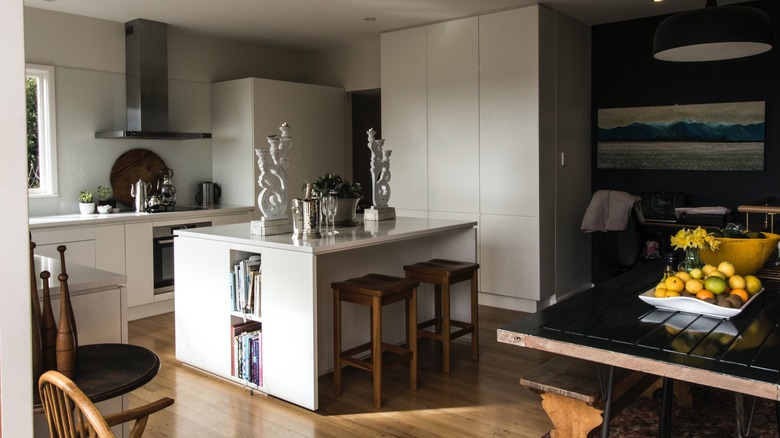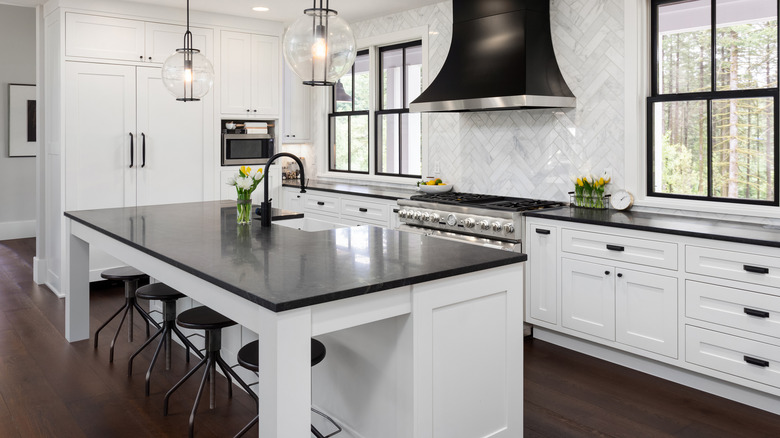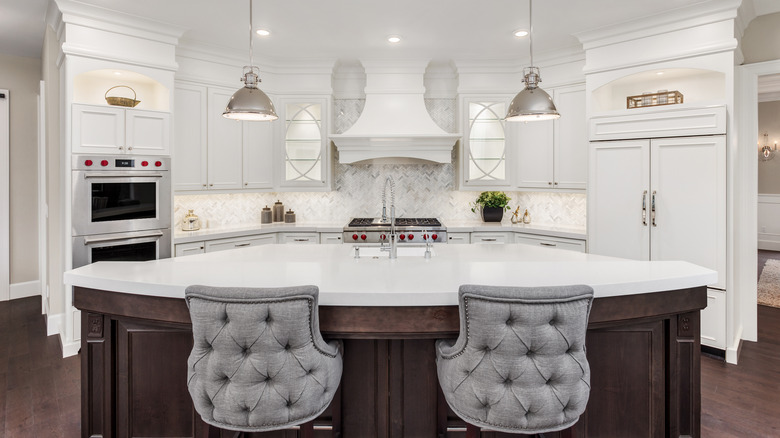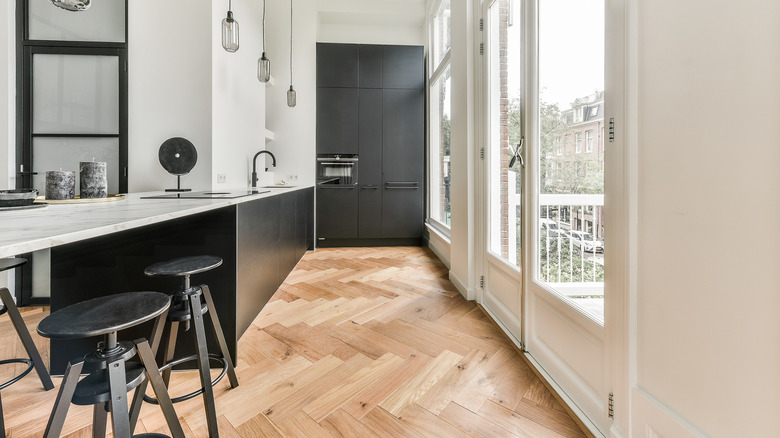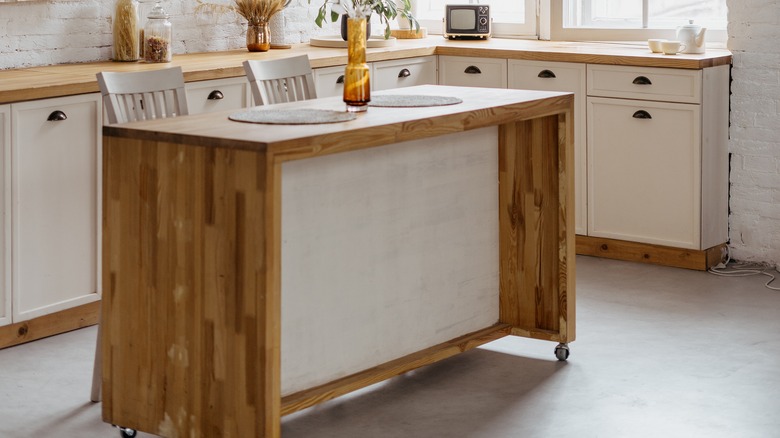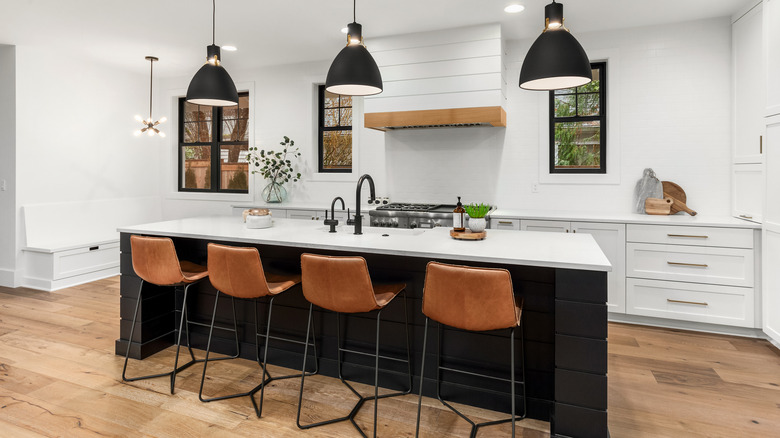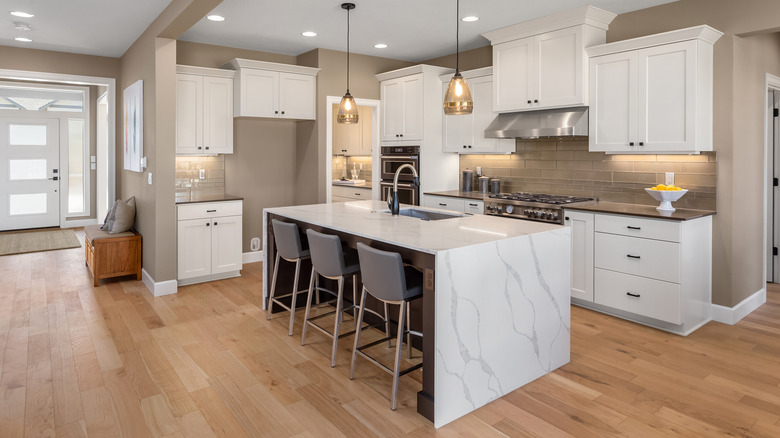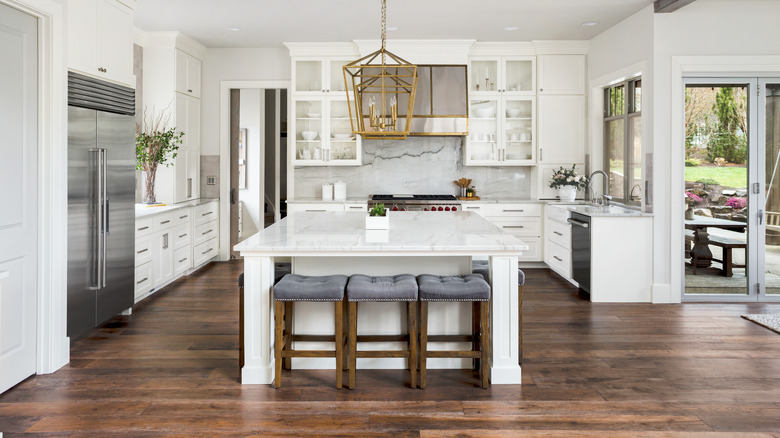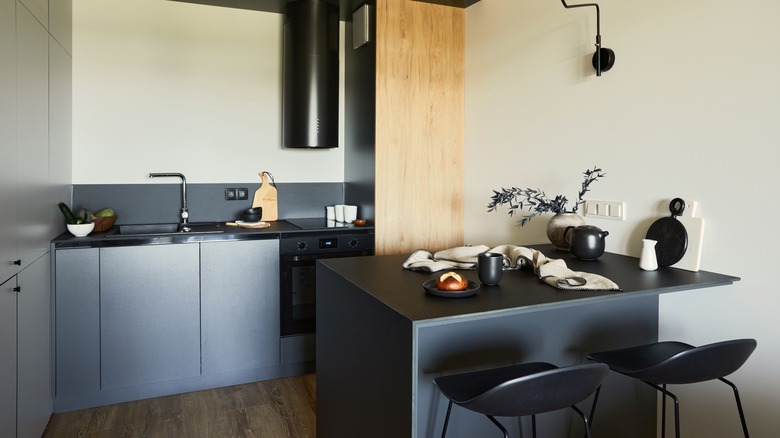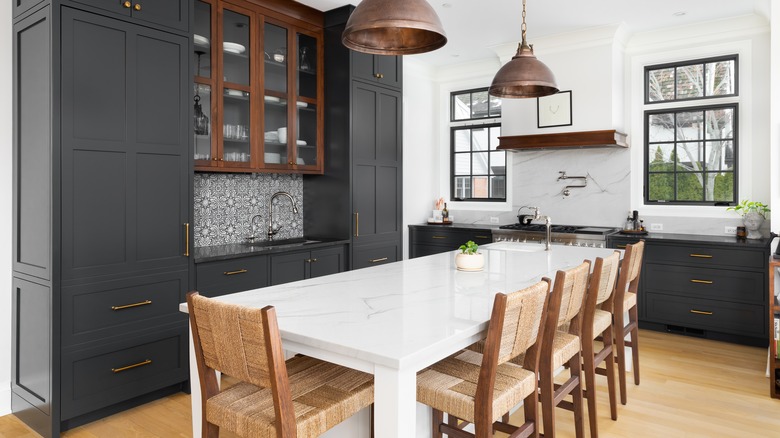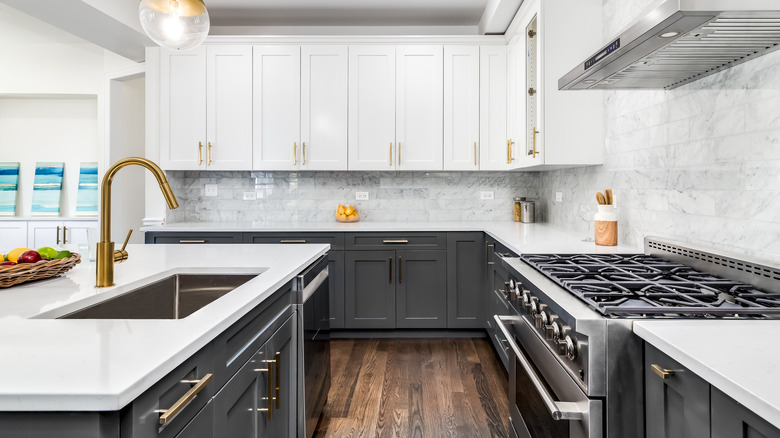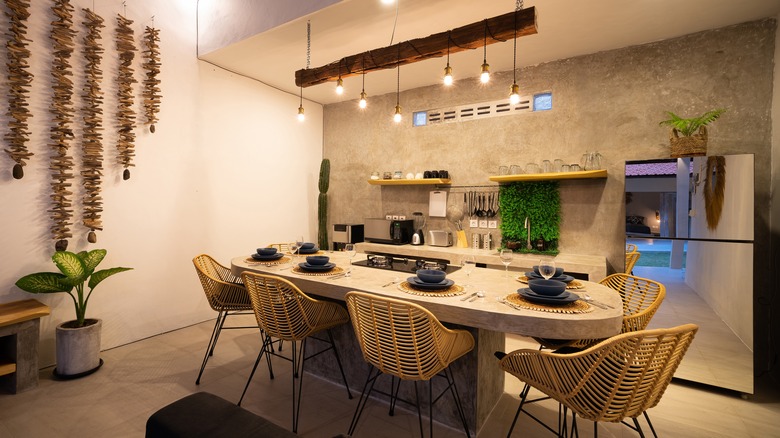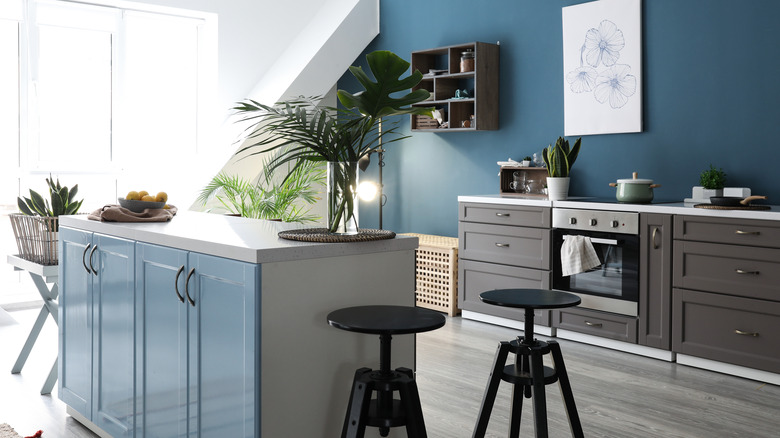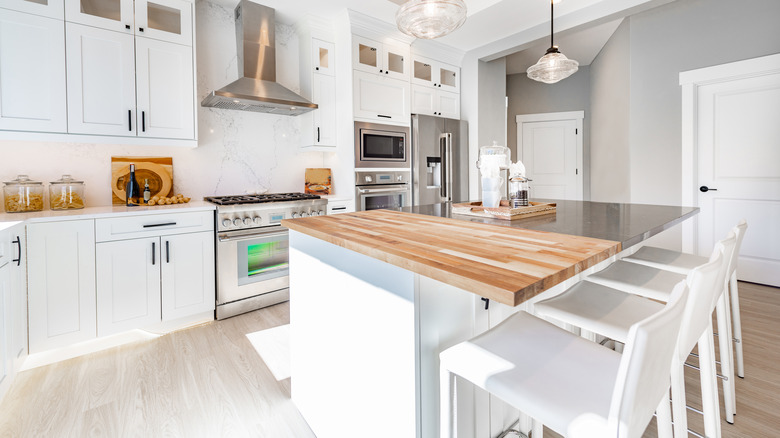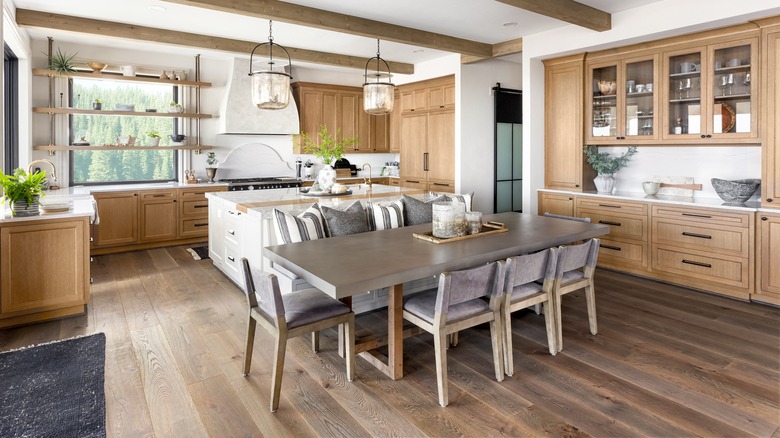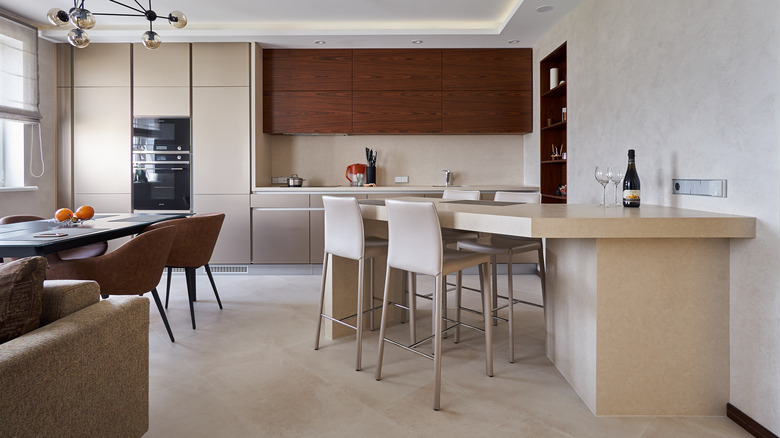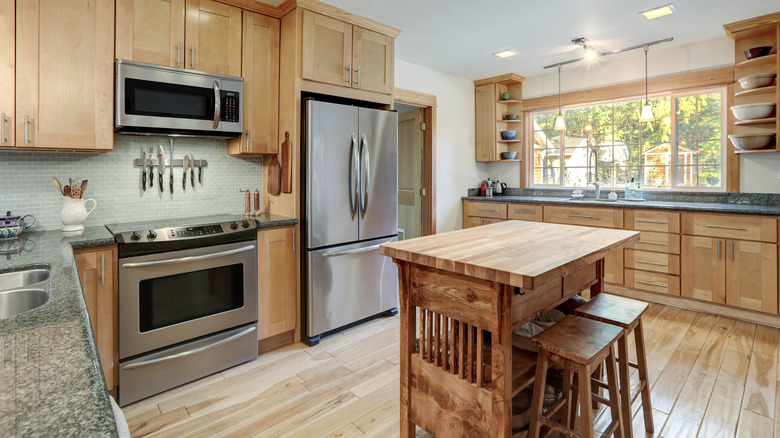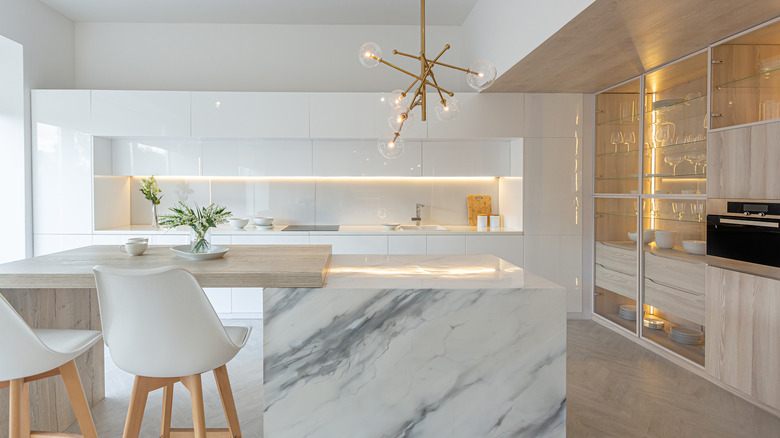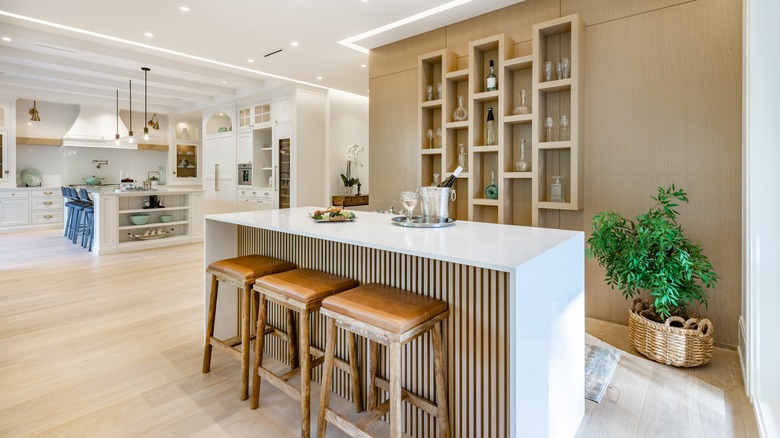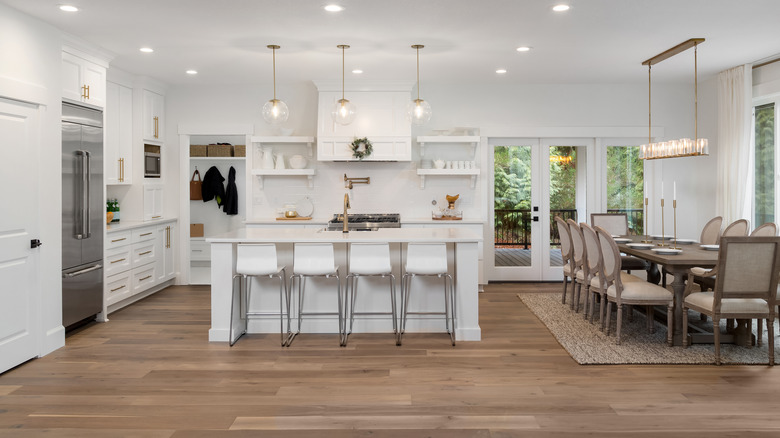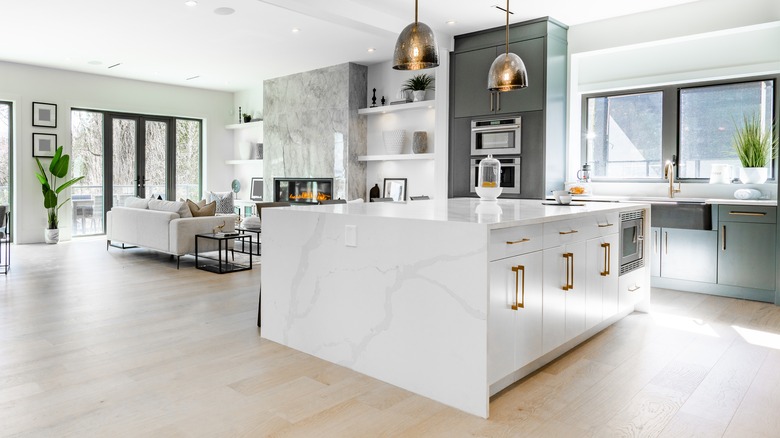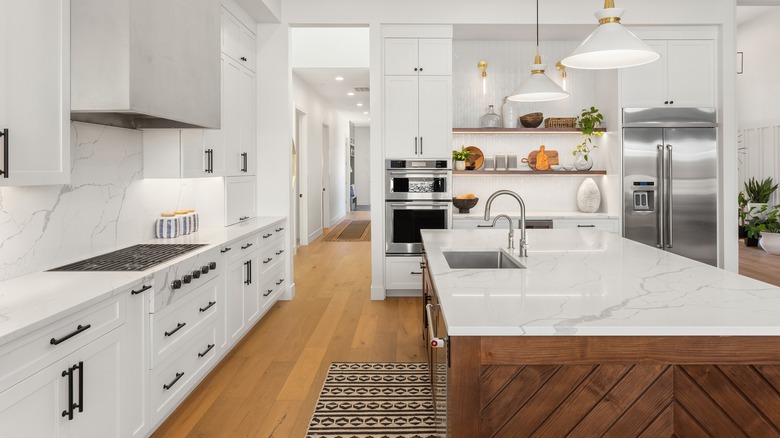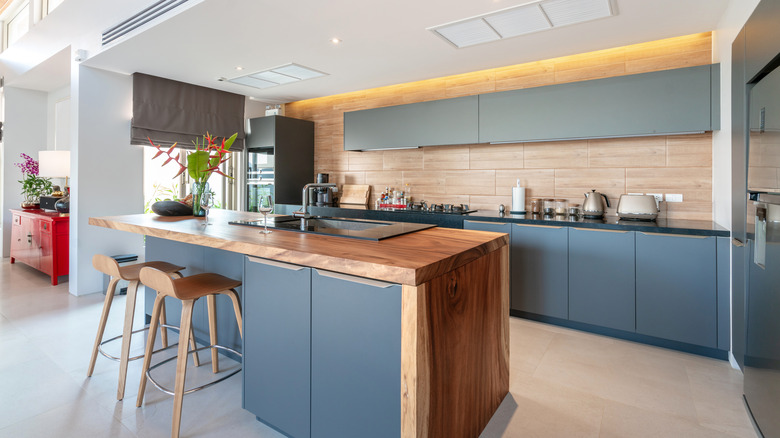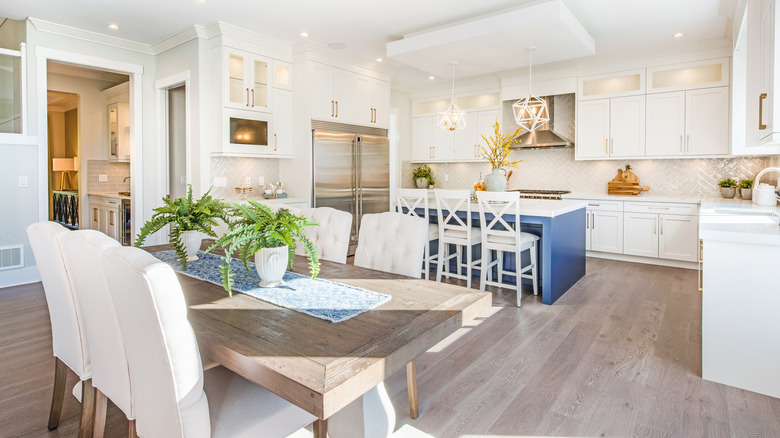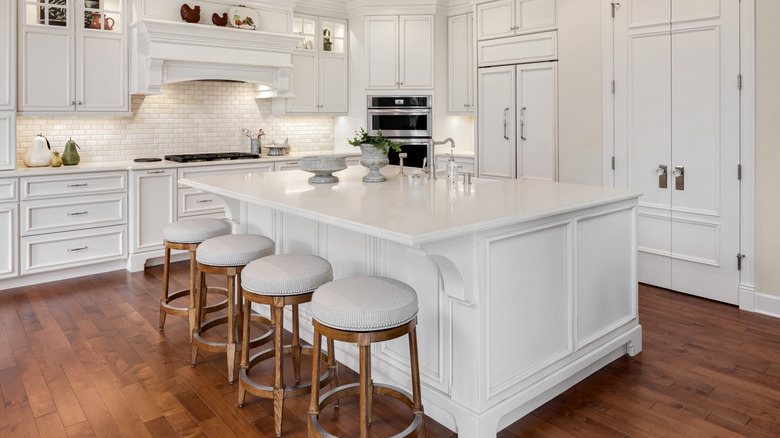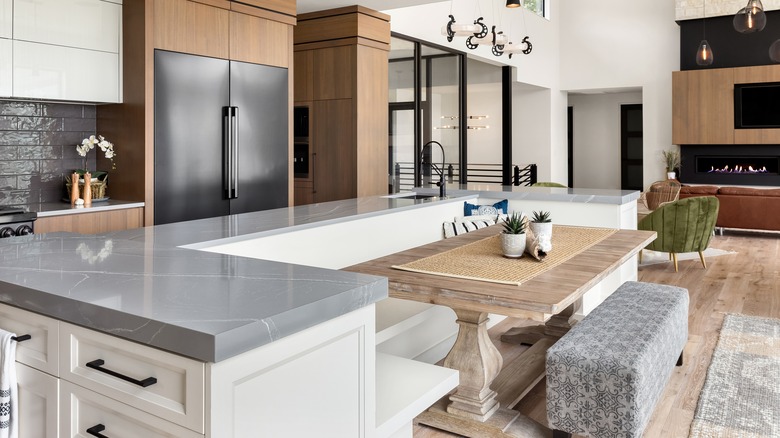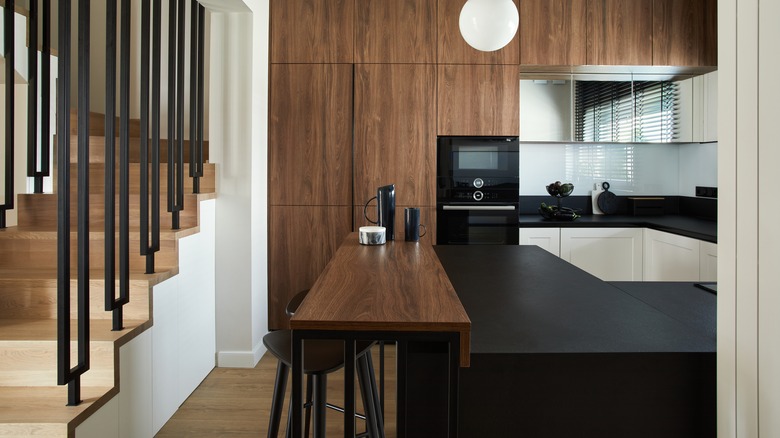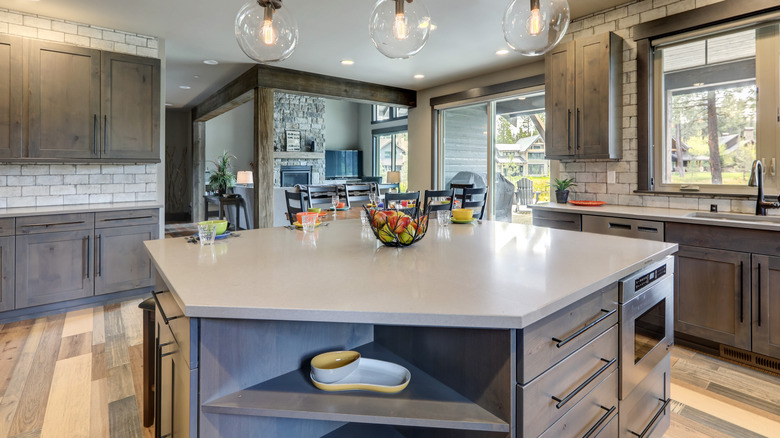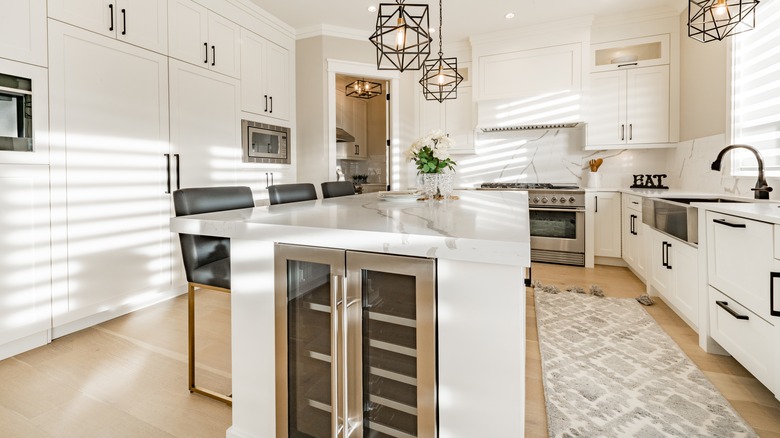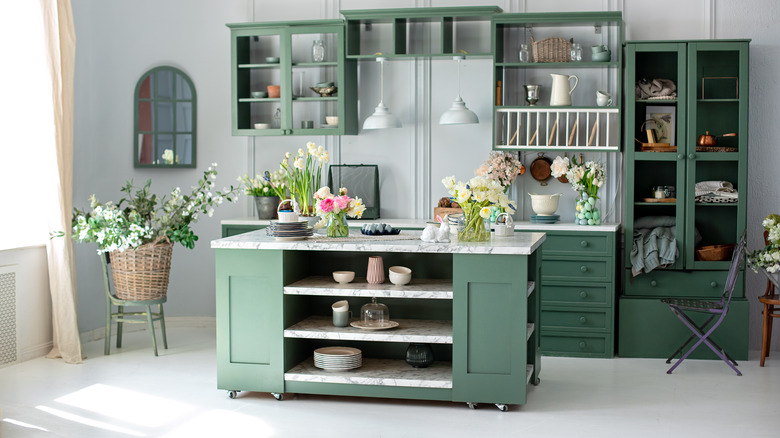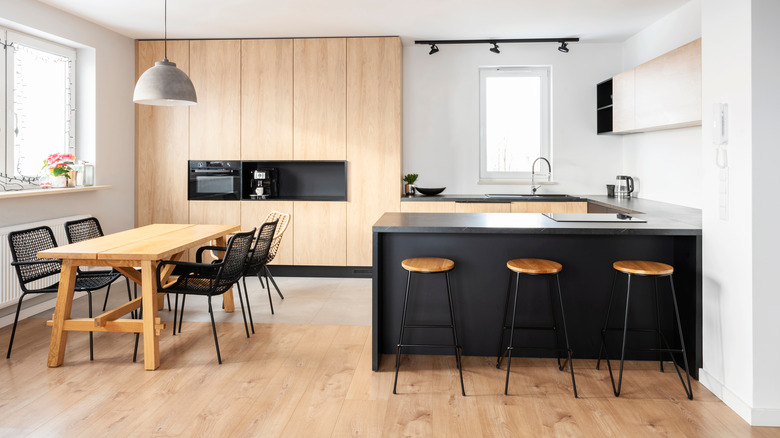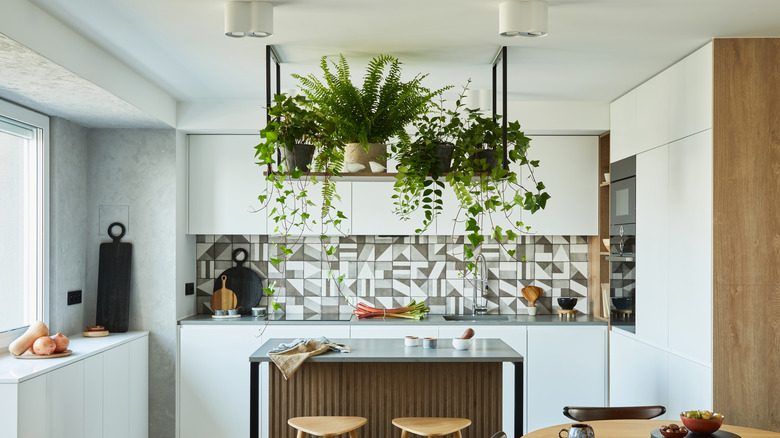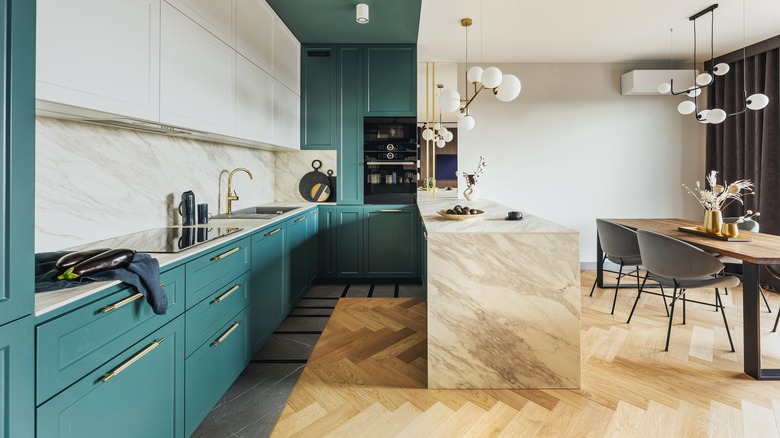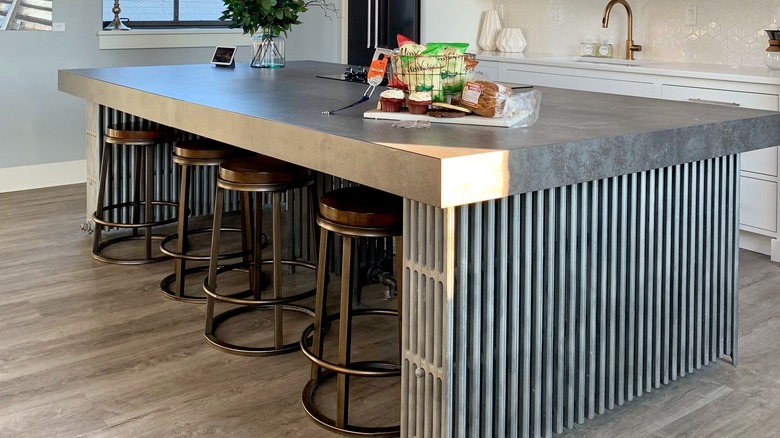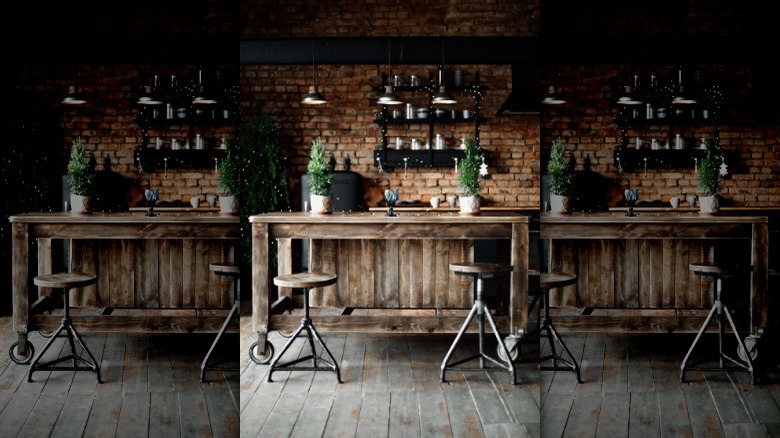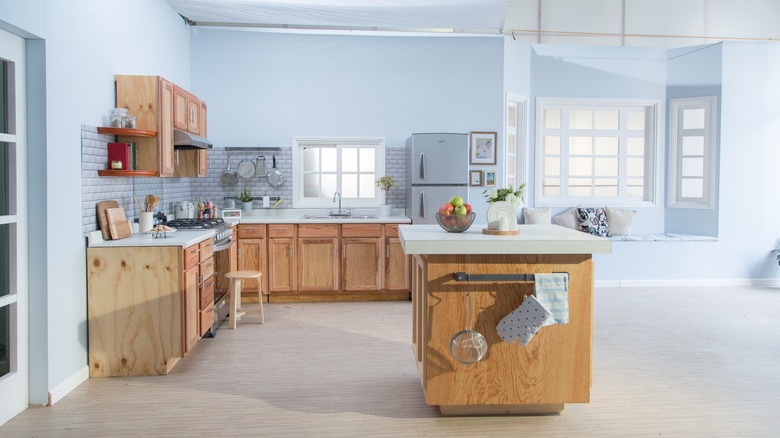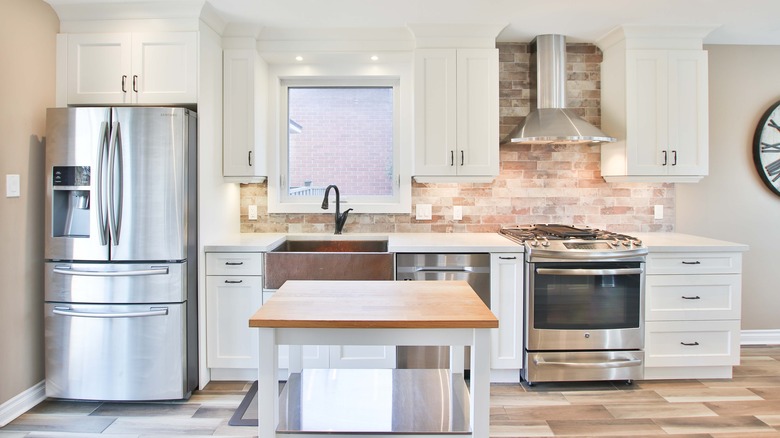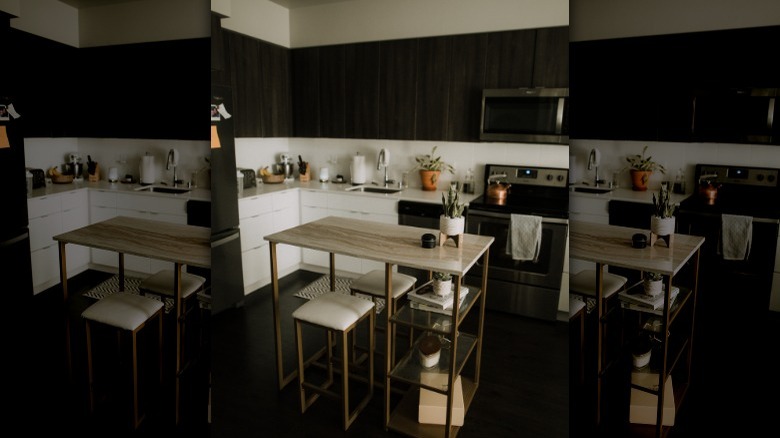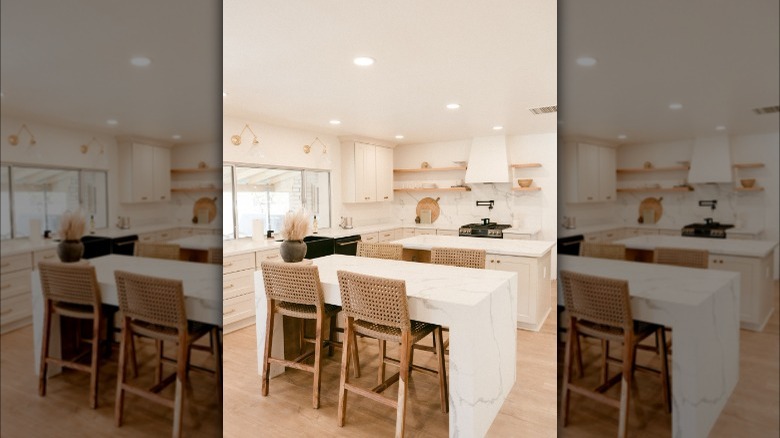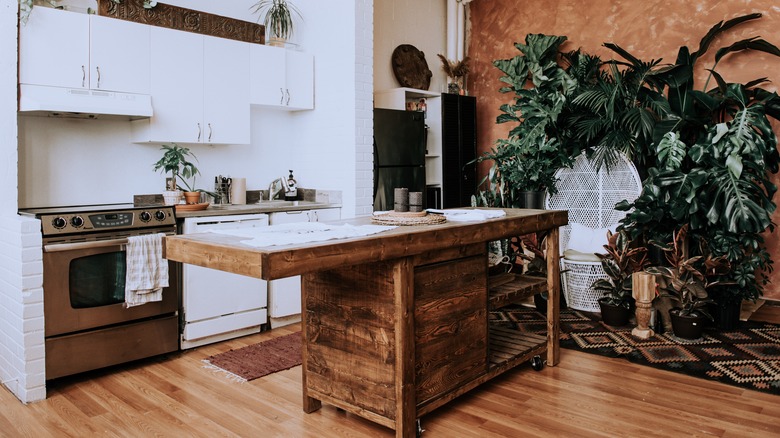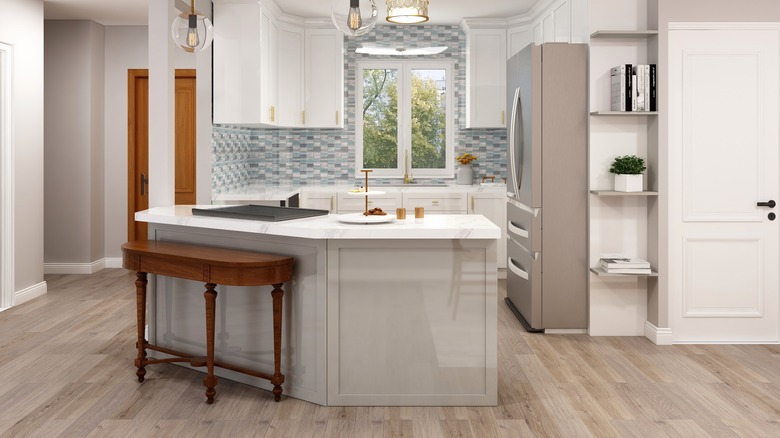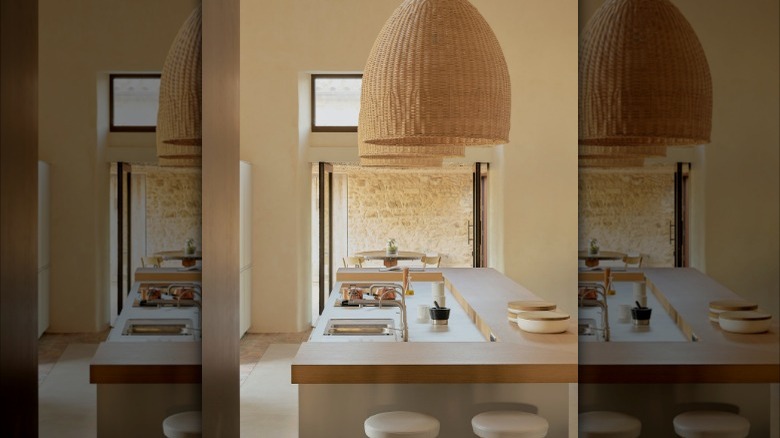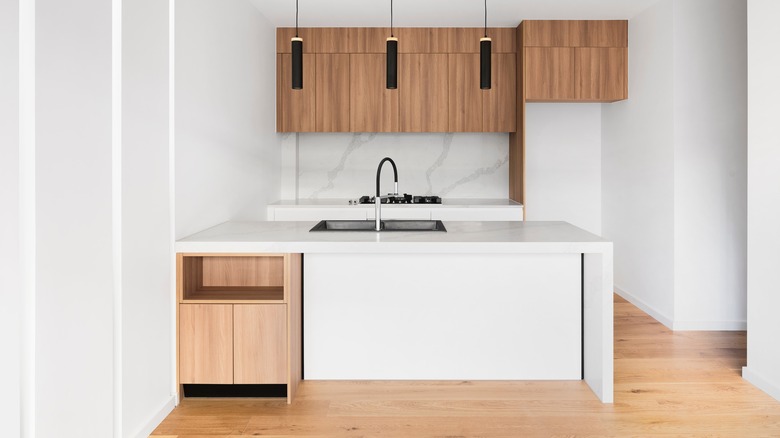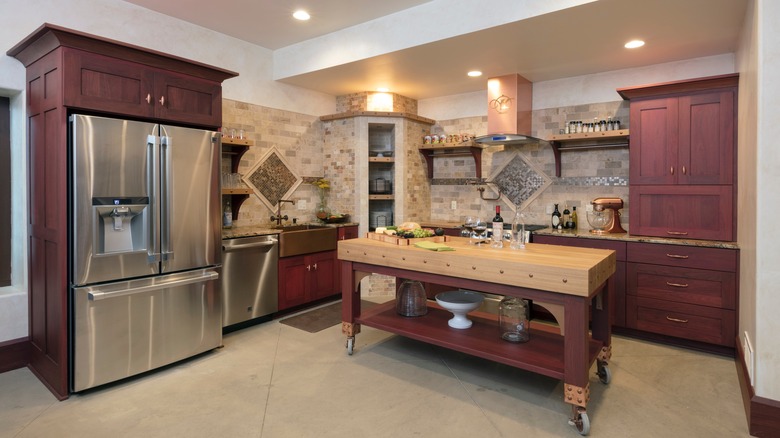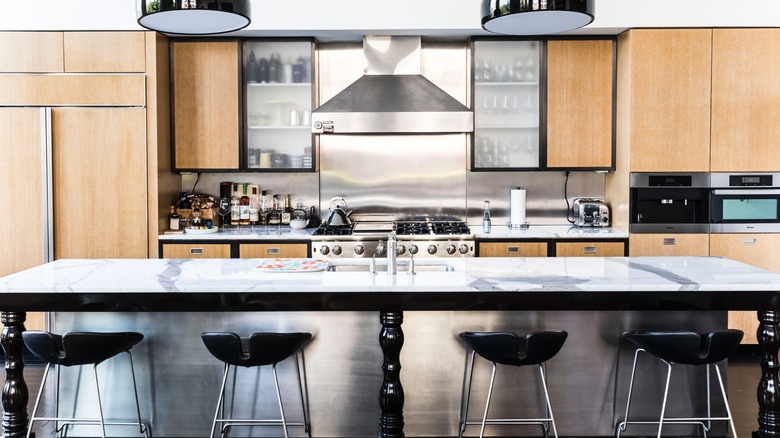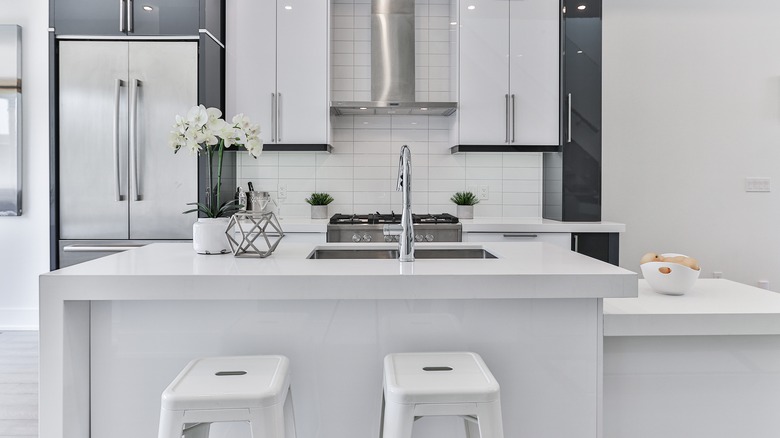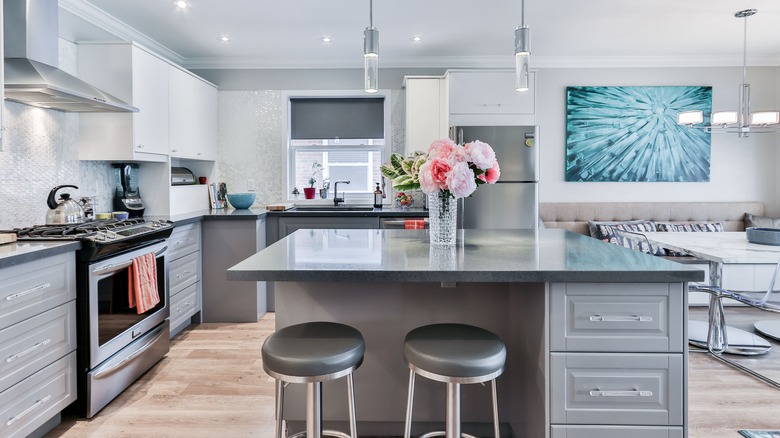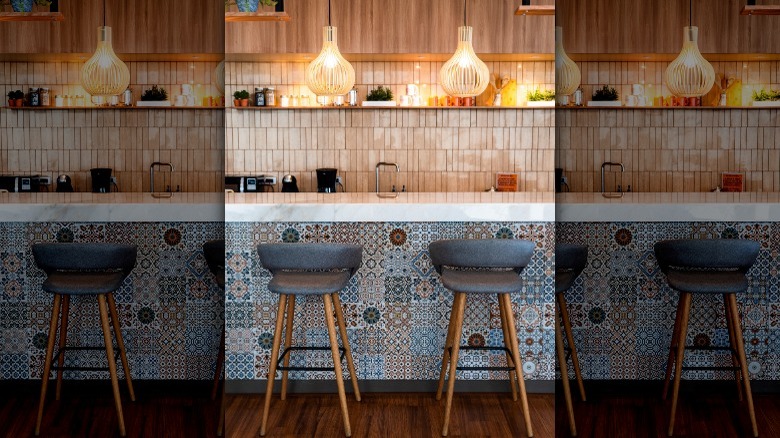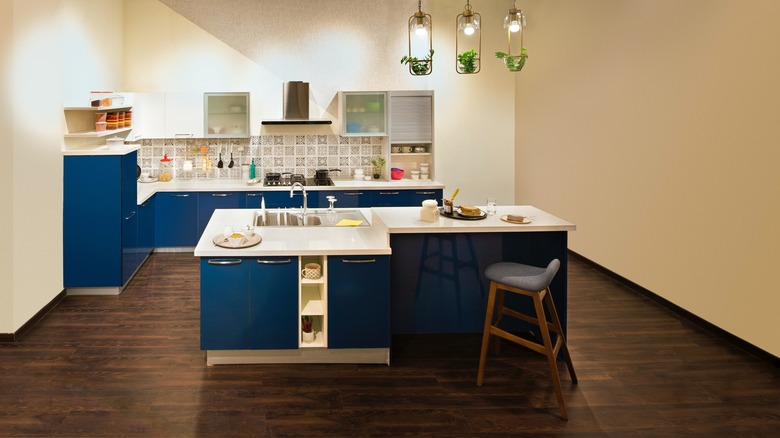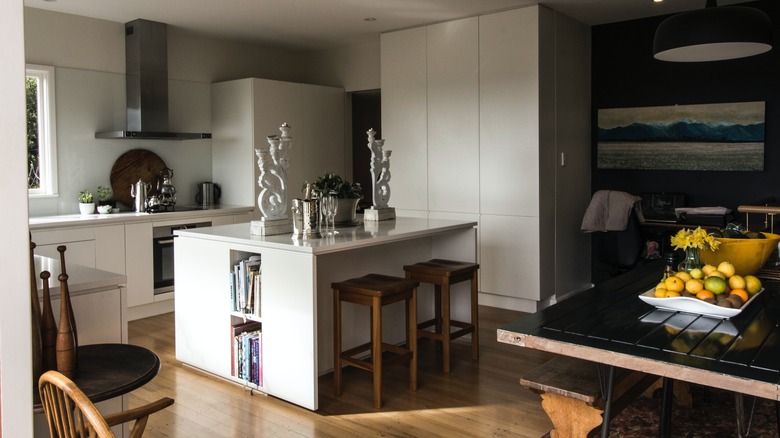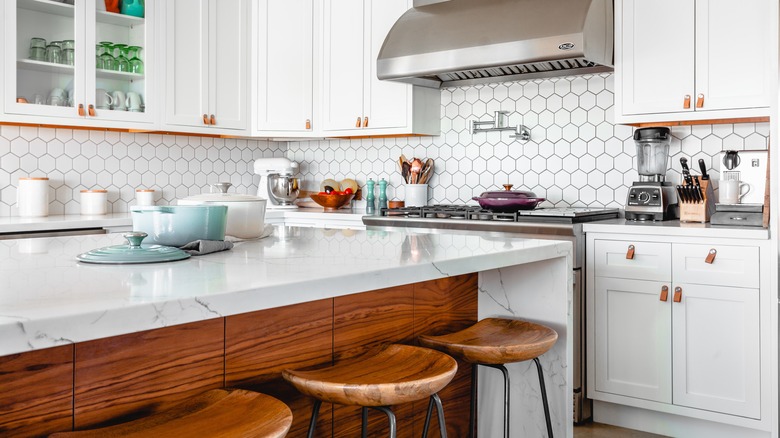50 Innovative Ways To Spice Up Your Kitchen Island
One of the most common kitchen upgrades is an adding island. These functional, built-in centerpieces usually have a lip or overhang on the outer edge, which allows you to set up bar stools for extra dining space or a breakfast bar. They create a casual, relaxing space to hang out at when you don't necessarily want to sit at a formal dining table. They are also a great place to reallocate your sink, dishwasher, or oven or add an extra drawer.
As Francini notes, islands also help make open-concept kitchens feel a bit more separated from the rest of the home, making your space seem more cohesive and tied together. Whether you're installing a new island or looking to spruce up the one you already have, you don't have to stick to a classic or traditional design. In fact, there are many ways to spice up your island and add either decorative appeal, functionality, or both.
1. Extra wide island
Consider installing an extra wide island, which allows you to have space for both dining and extra food preparation without compromise. It also helps fill up space in a larger, open-concept kitchen.
2. Rounded edge
For a unique finish, choose an island with a rounded edge instead of a standard straight one. This can help add some dimension to your kitchen or accentuate existing unique shapes.
3. Galley kitchen island
While galley kitchens aren't known for having islands, you can create a unique island-inspired area by extending your counters past the kitchen, building an unconventional island-counter combination.
4. Add wheels
If you don't want to commit to a major installation while simultaneously adding mobility and versatility to your kitchen, add wheels to your island. Move it around the space as needed.
5. Faux stone details
Add some visual intrigue to the base of your island by adding faux stone or brick detailing. Choose either a natural or sleek color, depending on the aesthetic of your space.
6. Waterfall edge
Waterfall countertop islands are a very eye-catching, luxurious addition to your kitchen. Choose a sleek marble for an even more luxe feel.
7. End cap breakfast bar
Instead of having your barstools set up on just the long edge of your island, choose instead to have them be on the short end, or even try both.
8. Half waterfall edge
If you don't want to commit to waterfall countertops on both sides of your kitchen island, choose one end for a sleek edge. This works best on an island bumped near a wall, helping create a more distinct edge.
9. Dining table island
Choose a long and sturdy dining table in a durable, heat-safe, food-grade material like marble, stone, or wood to place in the center of your kitchen instead of an island. Or alternatively, choose a long and slightly lower island and have it double up as a dining table.
10. Island sink
One of the most classic island alterations is to add a sink in the center. Not only does it free up actual counter space, but it adds some visual intrigue and breaks up a flat island countertop.
11. Round dining island
Similar to the earlier dining table-island combination, choose a large, natural stone slab island with unique rounded edges to make it feel even more like a dining table.
12. Cupboard edges
Instead of choosing an island with a lip for barstools or chairs, add a chair to either short end, and install outward-facing cupboard cabinets for extra storage space.
13. Butcherblock sliver
While butcherblock countertops are an excellent option for your kitchen island, make things even more interesting by only opting for a half butcherblock countertop. This can function as a dedicated preparation and workspace and add some dynamic contrast.
14. Bench installation
Fitting an island and a dining table in your kitchen can be difficult. Instead of struggling to squeeze them both in individually, maximize your space by installing a bench on the outer edge of your island.
15. Angled island
Make use of every square inch of a smaller apartment while still having the convenience of a kitchen island by angling it inward. This can open up the room while providing extra counter and dining space.
16. Antique flair
Add an antique, vintage flair to your kitchen by opting for a reclaimed butcher block table. This is especially great if you don't want the permanent installation of an island but you want the extra counter space.
17. Two-tier
Add some textural interest and create a unique sightline in your kitchen with a two-tier island. Choose a thick, sturdy marble base with a thinner wood bump out. This can also help separate your workstation from your dining area.
18. Inner wallpaper
A simpler way to spice up your island is to add a fun wallpaper inside where your barstools sit. This is a subtle, low-stakes way to add some color and pattern to your dining room.
19. Column ends
Choose thicker columns for the outer edge of your island instead of a basic flat wall — it's an easy way to add some classic detail.
20. Solid slab
If you aren't scared of a permanent installation and have plenty of space for a large island, add a thick, large marble or marble-edged square slab. This can help break up an open floor plan and add an unmatched sense of luxury to your kitchen.
21. Wood accents
If you want some wood accents in your kitchen but don't want to give up your gorgeous white counters and cabinets, choose an island with wood edges.
22. Contrasting waterfall edges
While most waterfall-edged islands either match the rest of the island or emphasize the color already there, they don't have to. Add a mid-century pop to your kitchen by choosing a warm wood waterfall edge and cool blue cabinets.
23. Pop of color
This next idea only requires a bucket of paint. Add a pop of color to a simple white kitchen by painting the base of your island a bright color. Add it throughout the kitchen in subtle but noticeable ways to help tie it together.
24. Corbels
Instead of a simple, straight-edged counter lip, add some corbels to either end for a classic look and some visual intrigue.
25. Booth build-in
If you have a larger family, the breakfast bar at the end of your island may not cut it. Instead, cut out a gap and install a dining booth or bench with a table, keeping enough island space for food preparation.
26. Raised breakfast bar
Another way to add a unique flair to your island while also differentiating the dining and preparation spots is by raising the bar area just a little bit.
27. Pentagon shape
Create some unique silhouettes in a larger kitchen with a big, pentagonal kitchen island. As a bonus, one end can function as open shelving.
28. Built-in wine fridge
Don't clog up your fridge with wine bottles. Instead, build a small wine or drink fridge on the end of your island.
29. Open shelving
If you don't need a breakfast bar or dining space, turn the ends of your island into open shelving for extra storage.
30. U-shaped
Bump out one end of an L-shaped kitchen to create an island and upgrade it to a U-shaped kitchen.
31. Hang some plants
If you don't want to update your actual island, consider updating the ceiling above it. Specifically, hang a ceiling-mounted shelf and add some trailing plants, which will climb down and create a beautiful, natural look.
32. Color blocking
Use the island to add contrast to your kitchen's color scheme. Contrast colorful wall cabinets with a stark neutral island, or vice versa.
33. Metal island
For a more industrial look, swap out a stone, marble, or wood kitchen island for a heavy metal base with a sturdy concrete counter.
34. Vintage cart
Instead of a traditional island, transform a vintage wheeled cart into a portable island. This would look great in a rustic or cottage-inspired kitchen.
35. Pots and pan rack
A simple addition to spice up your kitchen island while also making it more functional is to add a rack on the side, allowing you to hang pots, pans, towels, and other kitchen tools off the edge, ultimately freeing up even more storage space.
36. Traditional butcher block
Traditional butcher blocks are movable blocks on wheeled carts and are found in lots of professional kitchens even today. Add a professional edge to your kitchen with a more traditionally designed butcher block instead of a classic island.
37. Counter-height dining table
Another faux island option is a counter-height dining table. These tables add compact dining space in your kitchen, allowing you to store barstools underneath and out of the way. They usually have built-in shelves or cabinets for extra storage and also serve as extra preparation space without the commitment or cost of a real island.
38. Double island
If one island isn't enough for you, then double up! One island can be designed for food preparation and kitchen storage, and the other for dining. You can even create the illusion of a double island kitchen with a bar-height dining table in a sturdy material like marble or stone.
39. Drop leaf island
Instead of the traditional wide-edged lip that most islands have for extra dining, look for an island or island cart with a drop leaf edge. This allows you to have the convenience of extra dining or preparation space when necessary and store it out of the way when not.
40. Diagonal counter
Help distinguish the edge of your kitchen in an open floorplan house with a diagonal island, which helps cordon off the kitchen in a specified area.
41. Lowered sink
Another way to distinguish the separate functional areas of your island is by lowering the sink. Keep the rest of the island at bar stool height for dining while keeping your preparation and cleaning area separate.
42. Cabinet add-on
If you have more space for barstools than you need, consider slotting a small cabinet or storage shelf underneath. This doesn't even have to be a permanent installation if you find one short enough. Use it for extra kitchen storage or to merge your kitchen and living area in an apartment or studio.
43. Rolling island
If you like the functionality of a repurposed antique cart but you want the look of a permanent island, just opt for one on wheels. When the wheels are locked, it'll function like a typical island, but you can unlock them to move it around or out of the way as needed.
44. Extra long
For those who need a lot of dining and preparation space, choose a double-long island. Instead of two barstools, it can comfortably fit four underneath while adding that much extra counter space in your kitchen.
45. Multi level
A two-level island is also good for breaking up a monochrome space. It adds visual distinction and function — one side can be higher, fit for barstools, dining, and washing up, with another lower level for food preparation or presentation.
46. Drawers
If open shelving isn't your thing, add some drawers to the edge of your island instead. These can be used to help further organize your kitchen, holding utensils, towels, small appliances, spices, and more.
47. Mosaic backing
A simple aesthetic way to upgrade your kitchen island is to add assorted mosaic tiles to the wall. You can make it even easier with peel-and-stick tiles and play around with color mixing or matching with your barstools.
48. Display shelf
If you have a little extra room to spare, consider adding a small display shelf to the outer edge of your island. Show off your mug collection, memorabilia, seasonal décor, or whatever else you want.
49. Bookshelf
Another kitchen island shelving option is a bookshelf. Whether you choose to show off cookbooks or your own personal reading collection, this is a great way to add some more shelving storage to a smaller home or apartment.
50. Wood backing
Similar to the mosaic and wallpaper ideas, you can add a subtle touch of wood to your kitchen to help ground it with a wood backing. Again, this could be a peel-and-stick decal or a legitimate wood installation.
